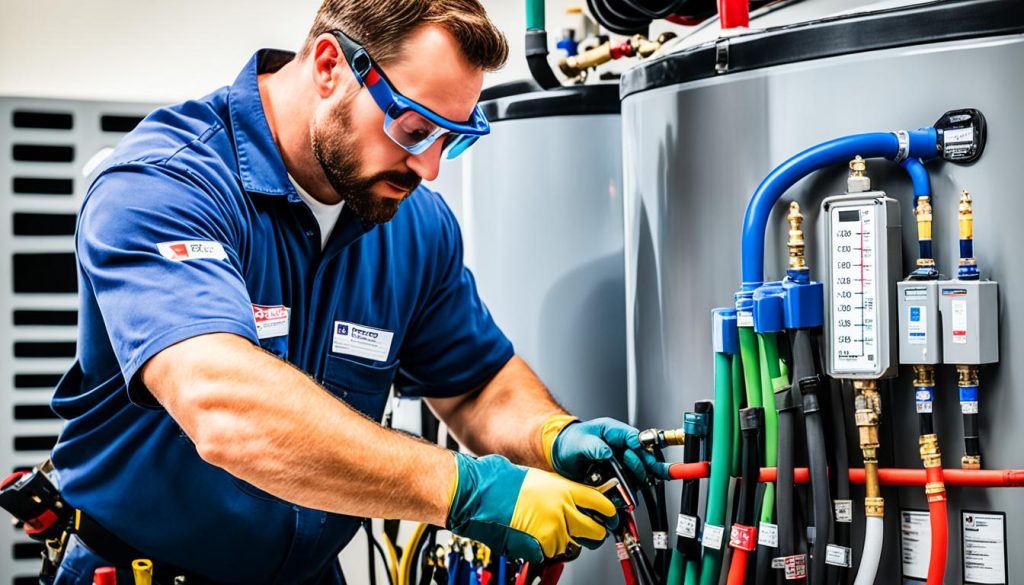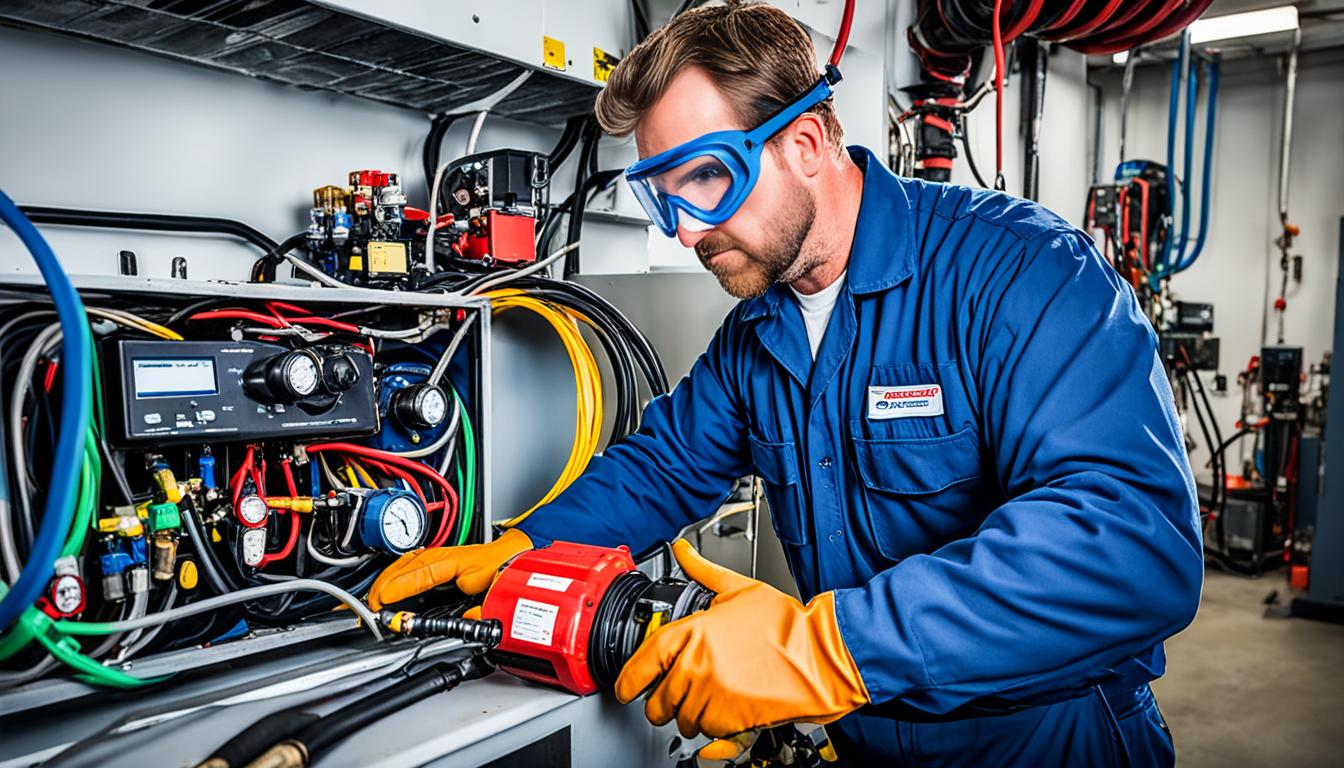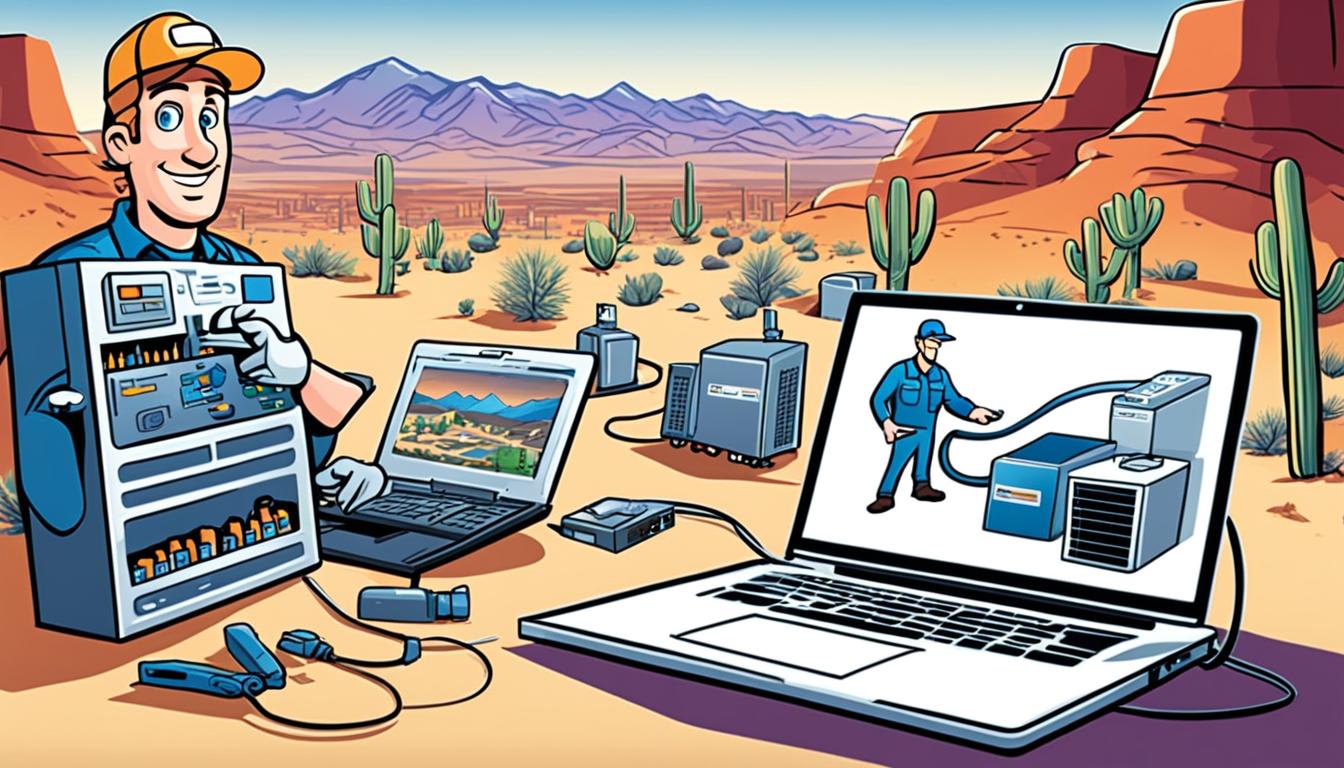Have you ever experienced the discomfort of walking into a sweltering room on a scorching summer day, only to find that your air conditioning system has failed? The frustration, the sweat trickling down your forehead, the desperate need for relief; it’s a situation none of us want to find ourselves in. As an AC repair contractor, you know the importance of keeping these systems in top shape, not just for the comfort of your customers, but also to comply with the legal requirements surrounding AC leak testing.
The regulations surrounding AC leak testing are vital not only for the preservation of our ozone layer but also for the safety of everyone who relies on these systems. By adhering to the legal guidelines for refrigerant leak testing, you can ensure that your AC systems are efficient, environmentally friendly, and pose no harm to your clients or the planet.
Key Takeaways:
- Understanding the legal requirements for AC leak testing is crucial for compliance and safety.
- Section 608 of the Clean Air Act prohibits the release of refrigerant during maintenance, service, repair, or disposal of AC and refrigeration equipment.
- Leak repair regulations apply to industrial process refrigeration, commercial refrigeration, and comfort cooling systems.
- Owners/operators must calculate leak rates, identify and repair leaks, perform verification tests, and conduct regular leak inspections.
- For larger systems, retrofit or retirement plans must be implemented if leaks cannot be repaired, and proper recordkeeping and reporting are mandated.
Section 608 Refrigerant Management Requirements
Section 608 of the Clean Air Act establishes crucial guidelines for refrigerant management in HVAC systems. As an AC repair contractor, it is vital for you to understand and comply with these regulations to ensure your operations are in line with legal requirements. Let’s explore the key aspects of Section 608 that you need to know!
Leak Repair Requirements:
To prevent the release of ozone-depleting refrigerants, owners/operators are obligated to repair any leaks that exceed specified thresholds. It is crucial to promptly identify and fix leaks to uphold environmental standards and maintain the efficiency of AC systems. Continue to perform leak rate calculations and verify the effectiveness of leak repairs to meet compliance standards.
Leak Inspections:
Regular inspections are essential to detect and address leaks promptly. By conducting routine leak inspections, you can identify potential issues and resolve them before they escalate. Remember, proactive maintenance and inspections contribute to optimal AC system performance and reduce the likelihood of refrigerant leaks.
Retrofit or Retirement Plans:
In cases where leaks cannot be successfully repaired, retrofit or retirement plans must be formulated. These plans outline the necessary steps to upgrade or replace equipment to eliminate refrigerant leakage. By implementing suitable retrofit or retirement strategies, you can mitigate environmental harm and promote sustainable practices.
Recordkeeping and Reporting Requirements:
Maintaining comprehensive records is a critical component of compliance with Section 608. These records should include the full charge of appliances, service and maintenance history, leak inspections, and retrofit or retirement plans. Adhering to proper recordkeeping and reporting procedures ensures transparency and accountability in your AC repair operations.
Summary of Section 608 Refrigerant Management Requirements:
| Requirements | Details |
|---|---|
| Leak Repair | Repair any leaks exceeding specified thresholds |
| Leak Rate Calculations | Calculate leak rate when adding ozone-depleting refrigerant |
| Leak Inspections | Conduct regular inspections to identify and address leaks |
| Retrofit or Retirement Plans | Create plans for equipment upgrade or replacement if leaks cannot be repaired |
| Recordkeeping | Maintain records of appliance charge, service history, leak inspections, and retrofit/retirement plans |
| Reporting | Comply with reporting requirements for transparency and accountability |
Recharging Systems and Leak Testing

When it comes to recharging AC systems, there are certain considerations to keep in mind, especially if there is a Freon leak. While there is no legal requirement to perform a leak test or repair before recharging a residential AC system that is low on Freon, it is important to understand the requirements for systems with larger refrigerant charges.
If the AC system contains more than 50 pounds of Freon, Section 608 of the Clean Air Act prohibits the release of refrigerant without proper leak testing and repairs. This regulation is in place to ensure that potential leaks are identified and addressed before recharging the system. It aims to minimize the environmental impact of refrigerant release and promote the safe and efficient operation of HVAC systems.
However, for smaller residential systems that are low on Freon, the legal requirement for leak testing and repairs before recharging is not applicable. Nonetheless, it is still considered best practice to identify and repair leaks before recharging any AC system, irrespective of size. This proactive approach helps to ensure the optimal performance and longevity of the system while minimizing potential disruptions caused by refrigerant leaks.
Requirements for Recharging a Leaking System
If you are recharging a leaking AC system, there are a few essential steps to follow:
- Identify the source of the leak: Conduct a thorough inspection of the system to determine the location of the leak. This may require the use of specialized leak detection tools.
- Repair the leak: Once the leak is identified, take the necessary steps to repair it. This may involve replacing faulty components, repairing damaged seals, or tightening connections.
- Perform a leak test: After the repair is completed, it is crucial to conduct a leak test to ensure that the system is no longer leaking refrigerant. This helps to verify the effectiveness of the repairs and avoid further refrigerant loss.
- Recharge the system: If the leak has been successfully repaired and the system is no longer losing refrigerant, you can proceed with recharging the AC system. Follow the manufacturer’s guidelines and use the appropriate refrigerant.
By following these steps and addressing any leaks before recharging, you can maintain the efficiency and reliability of the AC system, as well as align with the requirements set forth by Section 608 of the Clean Air Act.
State Regulations and Greenhouse Gas Emissions
The US Climate Alliance, consisting of state governors, is dedicated to reducing greenhouse gas emissions, including those produced by HVAC systems. To achieve this goal, several states have implemented regulations to restrict the use of high Global Warming Potential (GWP) refrigerants.
As part of this effort, manufacturers are actively developing HVAC systems that utilize lower GWP refrigerants, such as A2L refrigerants. These alternatives not only help lower greenhouse gas emissions but also contribute to environmental sustainability.
Furthermore, compliance with the UL 60335-2-40 standard is essential for the design and certification of HVAC equipment using low GWP refrigerants. This industry standard includes specific requirements for the installation of refrigerant leak detection systems, ensuring the early detection and mitigation of potential leaks.
By adhering to these regulations and standards, the HVAC industry can play a crucial role in reducing greenhouse gas emissions and promoting the use of environmentally friendly refrigerants. As an AC repair contractor, it is important to stay informed about the state regulations on greenhouse gases and the latest advancements in low GWP refrigerant technologies, enabling you to provide more sustainable and eco-friendly solutions to your customers.





0 Comments